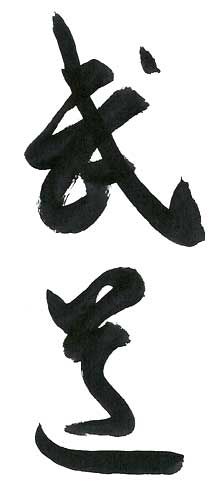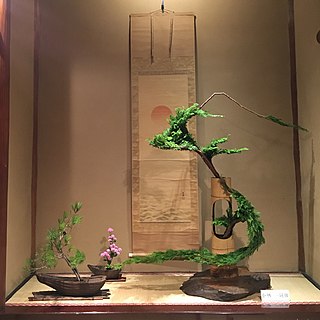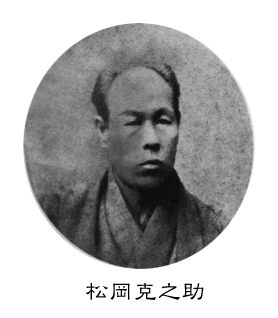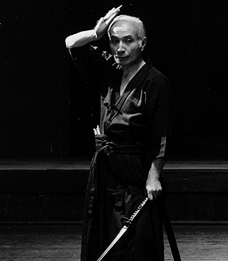Iaidō (居合道), abbreviated iai (居合), is a Japanese martial art that emphasizes being aware and capable of quickly drawing the sword and responding to sudden attacks.

Iaijutsu (居合術) is a combative quick-draw sword technique. This art of drawing the Japanese sword, katana, is one of the Japanese koryū martial art disciplines in the education of the classical warrior (bushi).

Budō is a Japanese term describing modern Japanese martial arts. Literally translated it means the "Martial Way", and may be thought of as the "Way of War" or the "Way of Martial Arts".

Gendai budō, or Shinbudō are both terms referring to modern Japanese martial arts, which were established after the Meiji Restoration (1866–1869). Kobudō or koryū are the opposite of these terms referring to ancient martial arts established before the Meiji Restoration.

Tenshin Shōden Katori Shintō-ryū (天真正伝香取神道流) is one of the oldest extant Japanese martial arts, and an exemplar of bujutsu. The Tenshin Shōden Katori Shintō-ryū was founded by Iizasa Ienao, born in 1387 in Iizasa village, who was living near Katori Shrine at the time. The ryū gives 1447 as the year it was founded, but some scholars state that it was about 1480.

Ko-ryū is a Japanese term for any kind of Japanese school of traditional arts. The term literally translates as "oldschool" or "traditional school". It is sometimes also translated as "old style".

Battōjutsu is an old term for iaijutsu (居合術). Battōjutsu is often used interchangeably with the terms iaijutsu and battō (抜刀).

Japanese martial arts refers to the variety of martial arts native to the country of Japan. At least three Japanese terms are used interchangeably with the English phrase Japanese martial arts.

Donald Frederick "Donn" Draeger was an internationally known teacher and practitioner of Japanese martial arts. He was the author of several important books on Asian martial arts, and was a pioneer of international judo in the United States and Japan. He also helped make the study of martial arts an acceptable topic of academic research.
Tendō-ryū (天道流), also known as Tendō-ryū naginatajutsu (天道流長刀術), is a koryū founded in 1582 by Saito Hangan Denkibo Katsuhide. The current headmaster is the 17th sōke Kimura Yasuko.
Toyama-ryū (戸山流) established in 1925 by a committee of senior experts of several sword traditions for the curriculum of the Rikugun Toyama Gakkō.

Shindō Yōshin-ryū (新道楊心流), meaning "New Willow School" is a traditional school (ko-ryū) of Japanese martial arts, teaching primarily the art of jūjutsu. The first kanji of the name originally translated into "新=New", but in the mainline branch the kanji for "new" was eventually changed into the homophonic "神=sacred". The name of the school may also be transliterated as Shintō Yōshin-ryū, but the koryu tradition should not be confused with the modern school of Shintōyōshin-ryū which is unconnected.
Maniwa Nen-ryū (馬庭念流) is a traditional school (koryū) of Japanese martial arts founded in 1591 by Higuchi Matashichirō Sadatsugu. Matashichirō was a student of Nen-ryū, and founded Maniwa Nen-ryū after receiving inka from Akamatsu Gion. It is currently headed by the 25th headmaster, Higuchi Sadahito.
Abe ryū or Abe-tate-ryū (安倍立流), also known as Abe-ryū Kendō, is a Japanese sword school founded by Abe Yoritō (安倍頼任) in the 17th century. Abe was a disciple of Taisha-ryū, an offshoot of Shinkage-ryū. He was considered a Kengō and instructor to the Akizuki-han in Chikuzen Province.

Risuke Ōtake full name Ōtake Risuke Minamoto no Takeyuki, was a Japanese martial artist. He was a long time shihan of Tenshin Shōden Katori Shintō-ryū bujutsu, which he learned as a disciple of the previous teaching master Hayashi Yazaemon (1892-1964) from the time he entered the school in 1942 at the age of 16. In 1967, when Otake-sensei was 42 years old, he received gokui kaiden, the highest level of attainment in the tradition, and at the same time became the school's teaching master. He lived and taught in rural location near Narita city, in Chiba Prefecture of Japan. The teachings of Tenshin Shōden Katori Shintō-ryū were designated an Intangible Cultural Asset of Chiba Prefecture in 1960, with Ōtake designated as guardian of the tradition.
Heijo Muteki Ryu, a Japanese school of swordsmanship (kenjutsu/kendo), founded by Yamanouchi Renshinsai. In c 1668, Yamanouchi Renshinsai described his swordsmanship as kendo.

Saitō Satoshi was the 5th generation Sōke of Negishi-ryū, a classical Japanese warrior tradition and the nation's last surviving specialist school of Shurikenjutsu. From 1997 to 2014, Saitō served as the elected Chairman of the Nihon Kobudō Shinkōkai, Japan's oldest classical martial arts association. In addition, Saitō was the 6th generation head of Shirai-ryū shurikenjutsu and the 15th Sōke of Kuwana Han-den Yamamoto-ryū Iaijutsu. In 1992, Saitō was awarded the Imperial Order of the Sacred Treasure.
Oishi Susumu Tanetsugu was a Japanese kenjutsu practitioner. He was active during the Tenpō period in the first half of the nineteenth century. A retainer of the Tachibana clan, he was unusually tall for a Japanese person of his day, standing seven fifoot inches (2.12 meters) tall.
Jikishinkage-ryū naginatajutsu (直心影流薙刀術) is a naginatajutsu koryū which claims to have descended from Kashima Shinden Jikishinkage-ryū. Despite this claim, Jikishinkage-ryū naginatajutsu does not appear to have any of the original rituals, esoteric teachings, body and weapon movements of Kashima Shinden Jikishinkage-ryū.












